At a first-ever Girl Summit in London, UNICEF released studies showing more than 130 million girls and women in Africa and the Middle East have experienced some form of female genital mutilation (FGM) and more than 700 million women in the world today were married as children.
The summit was sponsored by UNICEF and the government of the United Kingdom, to show the need for urgent action to end the two practices. The global chief of child protection for UNICEF, Susan Bissell, said the impetus for the conference was that there was an agreement between the two sponsoring institutions that “we need to up our game.
“We need to draw more attention to the related issues of female genital mutilation and cutting and child marriage, and we need to provide a platform for everyone around the world - organizations, individuals, government to commit themselves to eradicating harmful practices.”
A large international delegation of youth was joined by UNICEF executive director Anthony Lake and Britain’s prime minister, David Cameron.
Severe healthy risks of genital mutilation
The latest data released at the summit was collected from 29 countries in Africa and the Middle East where FGM is most prevalent. UNICEF officials say girls who undergo FGM are at risk of prolonged bleeding, infection, infertility and death, in addition to the extreme physical and psychological pain caused by the practice.
The new data on women who marry when they are children is equally compelling. “Over seven million women in the world today were married as children,” says Bissell. “So it’s quite astounding statistics.
“Now the good news is that data also tells us that these practices are on the decline,” says Bissell. However, she says if they only sustain current rates of decline as seen over the last three decades, the number of women married as children will remain flat to 2050.
“So, we will not see progress if we only move ahead the way we are right now,” says the child protection chief.
How to double reductions in both practices
One example of FGM reduction is found in Kenya and Tanzania where the rates of FGM have dropped by one-third of levels experienced three decades ago.
“Today, a girl is a third less likely to be cut than she was 30 years ago,” says Bissell. “So it’s possible to achieve change. But we mustn’t be frightened by the magnitude of the problem because we have solutions. But at the same time we have to say this is a wake-up call.
“What kind of a world do we want for our girls by the year 2050? We certainly don’t want another 700 million of them married as girls.”
The message from the summit, she says, is that a lot more has to be done on the local level to achieve the goal of doubling the reduction of occurrences of FGM and child marriages. Increased local community activism is key to changing local perceptions and escalating the pace of reduced FGM practices. That activism can also encourage young girls to stay in school and complete a secondary .
“Change happens from the inside out, from that community leadership,” says Bissell. “It requires collective change.” Bissell describes the social process. “If there’s a community A here, community B, over there, and if A and B can get together and agree, ‘We’re not going to marry off our girls--actually, we’re going to get all of our girls into school and keep them in there…’”
“These are the messages that we want to get out there,” Bissell says, “and what we think will happen, what most certainly will happen is we’ll also see a decline in maternal and newborn child deaths, by addressing child marriage.”













